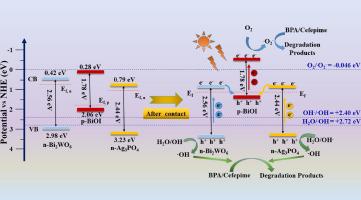Separation and Purification Technology ( IF 8.1 ) Pub Date : 2021-05-03 , DOI: 10.1016/j.seppur.2021.118866 Yanyang Chu , Baoyu Miao , Xianglei Zheng , Hongzhao Su

|
A flower-globular photocatalyst (Bi2WO6/BiOI@Ag3PO4-5) with symmetric double-heterojunction structure and low Ag-content was successfully fabricated for the first time by precipitation and one-step hydrothermal process. The loading of Ag3PO4 evidently enhanced the photoelectric properties of photocatalysts. Bi2WO6/BiOI@Ag3PO4-5 provided an ideal photocatalytic activity towards the degradation of bisphenol A (BPA) and cefepime under simulated sunlight, and it also exhibited well photocatalytic stability. For BPA degradation, the recommend photocatalyst provided nearly 100% of degradation efficiency and 65.4% TOC removal by the simulated sunlight irradiation of 120 min, while for cefepime degradation, it offered the degradation efficiency of 98.2% and the TOC removal efficiency of 33.4%. The mechanism of photocatalytic activity enhancement was owing to the loading of Ag3PO4 and the developed double-heterojunction structure, by which the absorbance of visible light, the separation of electron/hole (e–/h+) pairs and carrier mobility were enhanced evidently. It was found that superoxide anion radical (∙O2–) played the major role in BPA degradation, while hydroxyl radical (∙OH) and hole (h+) together played the key role in cefepime degradation. The two pathways for BPA and cefepime degradation were respectively proposed by identifying the byproducts formed during the degradation. In addition, it was found that the photocatalytic degradation of cefepime evidently enhanced the biodegradability of the solution.
中文翻译:

花球形Bi2WO6 / BiOI @ Ag3PO4光催化剂的制备用于在阳光下降解双酚A和头孢吡肟:光电性能,降解性能,机理和可生物降解性增强
通过沉淀和一步水热法首次成功制备了对称的双异质结结构且Ag含量低的花球状光催化剂(Bi 2 WO 6 / BiOI @ Ag 3 PO 4 -5)。Ag 3 PO 4的负载明显增强了光催化剂的光电性能。Bi 2 WO 6 / BiOI @ Ag 3 PO 4-5对模拟的日光下双酚A(BPA)和头孢吡肟的降解提供了理想的光催化活性,并且还表现出良好的光催化稳定性。对于BPA降解,推荐的光催化剂在120分钟的模拟阳光照射下提供了近100%的降解效率和65.4%的TOC去除率,而对于头孢吡肟的降解,它提供了98.2%的降解率和33.4%的TOC去除率。光催化活性增强的机理归因于Ag 3 PO 4的负载和发达的双异质结结构,通过该结构,可见光吸收,电子/空穴的分离(e – / h +)对和载流子迁移率明显提高。发现超氧阴离子自由基(∙O 2 –)在BPA降解中起主要作用,而羟基自由基(∙OH)和空穴(h +)一起在头孢吡肟降解中起关键作用。通过确定降解过程中形成的副产物,分别提出了BPA和头孢吡肟降解的两种途径。另外,发现头孢吡肟的光催化降解明显增强了溶液的生物降解性。











































 京公网安备 11010802027423号
京公网安备 11010802027423号